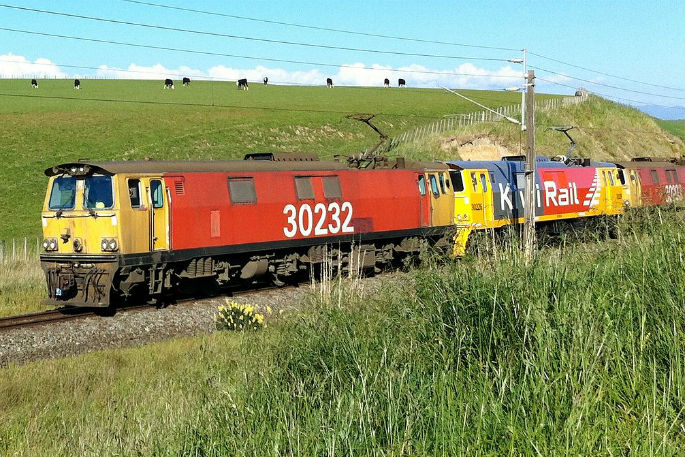KiwiRail's decision to phase out electric trains on the North Island Main Truck line between Hamilton and Palmerston North is being slammed as environmentally unsustainable by Council of Trade Unions president Richard Wagstaff.
KiwiRail chief executive Peter Reidy says every tonne of freight carried by KiwiRail reduces the carbon emissions from trucks.
'We should not lose sight of the fact that last financial year freight carried by rail in New Zealand meant 1.1 million fewer truck trips, 76.7 million fewer litres of fuel used, and 208,613 fewer tonnes of greenhouse gas emitted and that was with a largely diesel fleet.”
The announcement that KiwiRail will be replacing the electric engines with diesel powered ones is not the right decision for a country, which prides itself on its clean green reputation, says Richard.
'Words speak louder than actions, and the Government's actions with KiwiRail demonstrate a fixation with cost cutting and a complete lack of concern for the environment and climate change.
'Instead of forcing KiwiRail to revert to carbon based fuel because it is more financially sustainable, the Government should have insisted on KiwiRail leading the way with electricity and funded them to do so.
'As well as this decision being terrible for our environment there are also consequences for those who have worked on the electric trains. We need to be supporting people with these skills, not telling them their futures are uncertain.”
'We all know that the way of the future is electric powered vehicles – KiwiRail needs the funding from Government to join the future.”
KiwiRail announced on December 21 it has decided the small fleet of almost 30 year old electric trains operating between Hamilton and Palmerston North will be phased out over the next two years and replaced with diesel locomotives. The electric infrastructure on the line is to remain in place and be maintained to a safe standard for any future use.
The North Island Main Trunk from Auckland to Wellington is electrified only between Hamilton and Palmerston North.
KiwiRail is essentially running 'a railway within a railway” by having the electric section, says Peter.
'Imagine having to change planes at Hamilton and again at Palmerston North, just to fly from Auckland to Wellington. That's not efficient, it's more costly and ultimately delivers a less reliable service.
'The doubling up of service facilities, inventory, training and maintenance required with two separate systems on the line adds to the inefficiencies and unreliability,” says Peter.
The decision took more than two years to make and included extensive consultation with international experts, unions and other consultants.
KiwiRail investigated four main options: replace the electric fleet with used or new electric trains; upgrade the current electric fleet or replace them with diesel trains as used on the rest of KiwiRail's network.
The 16 electric trains were breaking down on average every 30,000 kms which is well below the fleet target of every 50,000 km. 'Doing nothing was not an option,” says Peter.
Only eight new diesel trains need to be purchased as other existing diesel trains can be used more efficiently to cover the work of the electric trains.
Efficiency was not the only factor involved in the decision – environmental factors were assessed alongside the driving factors of reliability and performance improvement for customers.
'This is an important move for New Zealand as without a reliable and efficient service, our customers will not move freight on rail and every tonne of freight moved by rail delivers a 66 per cent reduction in carbon emissions from road. That's critical for our customers, and for the country.”
The decision to choose the diesel option wasn't made lightly or hastily, says Peter.
'We looked long and hard at the electric options and for our business, and most importantly our customers, they just did not stack up.
'Ultimately the high costs of a new or refurbished electric fleet couldn't be justified, while the gains to be made from standardising our fleet were very compelling.”
The cost of electrifying the whole NIMT is estimated at more than $1 billion for the infrastructure alone and feeder lines would still require diesel trains.
Retaining the electric infrastructure leaves the way open for future use if required. 'This is not a forever decision.”
A small number of staff may be affected by the change but staff and unions will be consulted well before the phase-in begins.
'Our preference is always to redeploy our people where possible and the project will take up to two years to implement,” says Peter.



2 comments
Just do the maths!
Posted on 22-12-2016 17:53 | By SonnyJim
Clearly the Union has not read the maths behind the decision! And that the power substations are too valuable to abandon, so will be maintained for later use as the natural fall-back position for when better electric locos can be purchased. "Going diesel" is not permanent.
all
Posted on 22-12-2016 18:12 | By Capt_Kaveman
of nz rail newtork should electric, this is a big fail since the power company stuff up, most think Muldoon was an idiot but time has told the story as nz has been sold out hence why the problems we have now because of shareholders and capitalists
Leave a Comment
You must be logged in to make a comment.